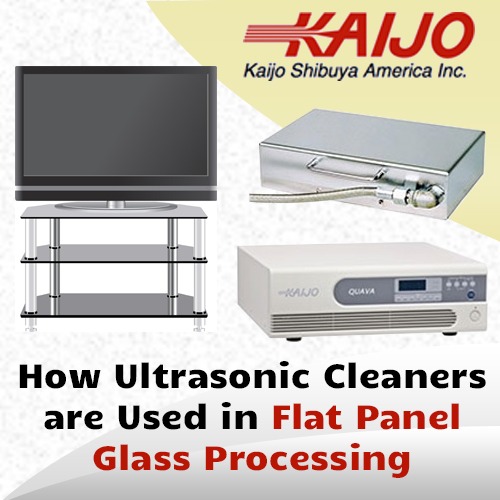Using Ultrasonic Cleaners in Flat Panel Glass Processing
January 16, 2019
 Flat panel glass is used in many flat screen products and its processing relies on a wide variety of manufacturing steps that apply coatings, add semiconductor functions and carry out special treatments of the glass. The manufacturing steps often leave process residues and the glass itself can pick up dirt and contaminants from the shop environment. Before it can be processed further, flat panel glass has to be cleaned thoroughly. Traditional cleaning methods using harsh chemicals or mechanical scrubbing are slow, labor-intensive and the cleaning solution has to be disposed of safely. Industrial ultrasonic cleaners that are used in these applications use only mild detergents, clean quickly and completely and are safe for the environment.
Flat panel glass is used in many flat screen products and its processing relies on a wide variety of manufacturing steps that apply coatings, add semiconductor functions and carry out special treatments of the glass. The manufacturing steps often leave process residues and the glass itself can pick up dirt and contaminants from the shop environment. Before it can be processed further, flat panel glass has to be cleaned thoroughly. Traditional cleaning methods using harsh chemicals or mechanical scrubbing are slow, labor-intensive and the cleaning solution has to be disposed of safely. Industrial ultrasonic cleaners that are used in these applications use only mild detergents, clean quickly and completely and are safe for the environment.
Ultrasonic Cleaning for Cut Glass Panels
Before any further processing can be done, glass sheets have to be cut, edges polished, and corners rounded. The resulting flat glass panel of the desired shape and size can then receive additional treatments and processing. Cutting and polishing can leave glass particles on the finished sheets and the sheets can pick up contaminants from being held and handled.
Ultrasonic cleaners can remove all particles and contaminants such as grease, or shop dust. The cleaning process uses ultrasonic transducers to generate ultrasonic waves and tiny cavitation bubbles in a bath with either plain water or a mild detergent. The creation of the bubbles results in a strong scrubbing action that dislodges particles and removes contaminants from the glass surfaces. The bubbles appear everywhere the cleaning solution can penetrate, and cleaning action is rapid, complete and takes place on all surfaces.
Cleaning Processed or Coated Panels
Once flat glass panels are cut to size and cleaned, additional process steps can add color or polarizing filters, layers for liquid crystal displays or chip on glass applications. For each of these process steps, a clean glass surface is essential. Filters will not form properly or adhere to the glass if contaminants or particles are present. Stray particles on the flat panel glass surface can result in dead pixels for LCD displays and may inhibit the correct functioning of semiconductor components for chips on the glass. Any contamination can reduce the quality and lifespan of the final glass panel products.
While each of the process steps requires cleaning of the glass panel, the actual cleaning requirements may be different. For rough cleaning and removal of heavy contamination from the glass itself, the strong cleaning action of a low-frequency ultrasonic system may be appropriate. For filter coatings and chip on glass cleaning requirements, high-frequency systems delivering gentle cleaning without damaging delicate films and components may be needed. For specific contaminants, a mild detergent designed to dissolve the contaminating material can speed up the cleaning process while heating the ultrasonic bath can help with the removal of material that softens with high temperature. Because there are many cleaning applications in flat glass panel manufacturing, it can be necessary to define specific requirements and customize ultrasonic systems to meet them.
Integrating Ultrasonic Cleaning in Flat Panel Manufacturing
Kaijo can help flat panel manufacturers add ultrasonic cleaning processes to their production and offers free consulting to define the problem and design custom solutions. The company has a complete line of industrial ultrasonic cleaners and has the expertise to customize standard products to meet specific cleaning requirements.
Kaijo supplies both turn-key ultrasonic cleaning systems and components suitable for the flat panel manufacturing industry. Turn-key systems can be placed in a manufacturing facility and are ready for immediate use. Separate components are useful if infrastructure such as cleaning tanks already exists, and ultrasonic generators and transducer can be added to work with existing systems. In each case, Kaijo can evaluate the cleaning application and suggest solutions that will improve facility performance.





